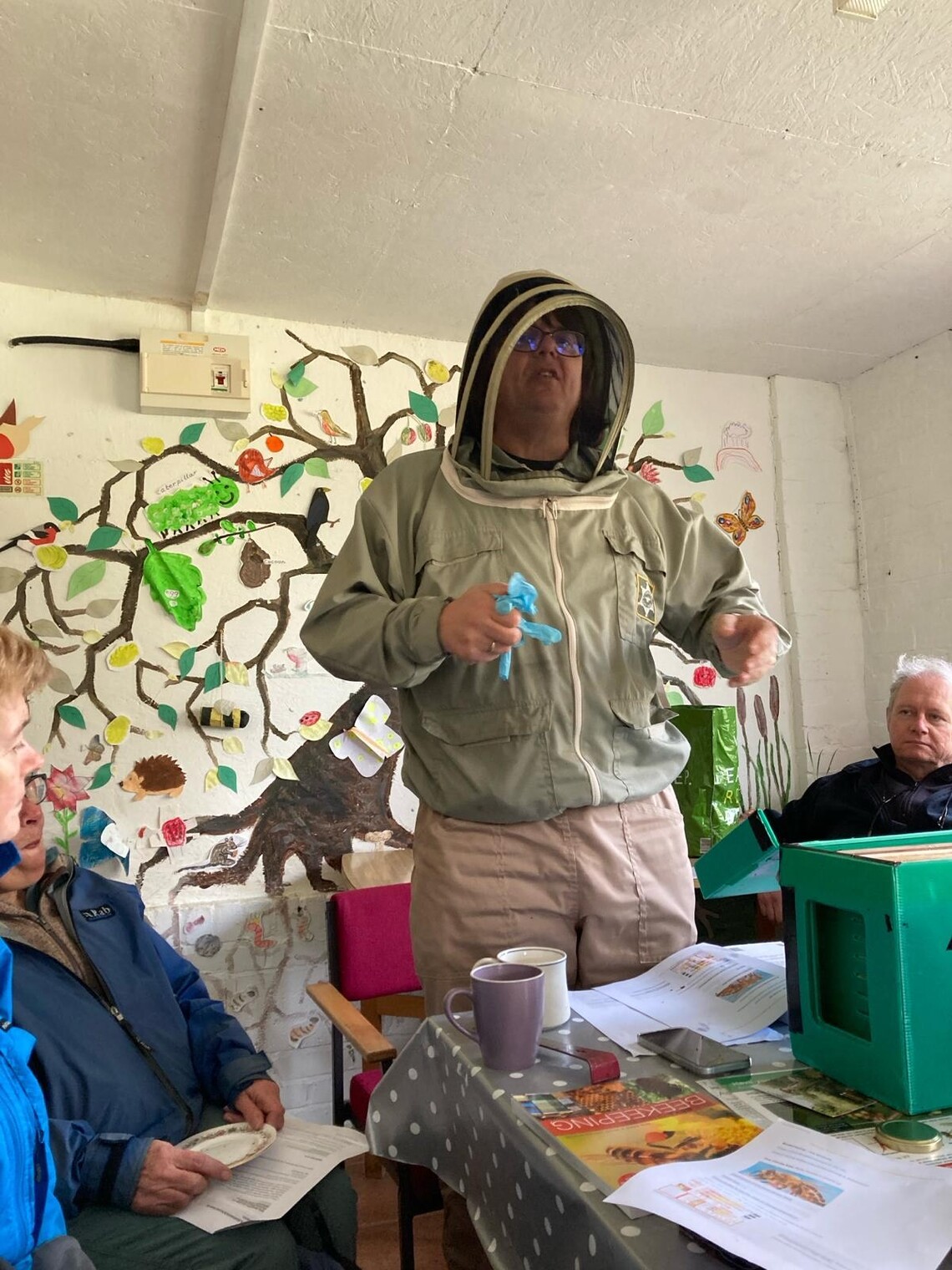“It’s all about the bees” was the first Learn and Grow session at Woodseats Allotment Hub. Many thanks to Peter Jackson (Jack) from plot 111 for his excellent and engaging talk, sharing his knowledge and answering so many questions, and also to the 20 or so society members who attended.
Jack began his journey, as a beekeeper, with a bee keeping course 4 years ago, a birthday present! He now has 2 hives on his allotment (permission needed from the council) and 5 at home.
Jack provided a lot of fascinating information and showed us some of the equipment, including PPE, a 'nuc' box with 6 frames in which his bees were collected from Sheffield Beekeepers, some wax items and samples of his delicious honey, of which he produces around 80 jars each year. We learnt about the different types of bees: queens, drones and workers and even ‘estate agent’ or scout bees, who seek new locations for a hive, as well as the life cycle of bees, bee communication and reproduction, hive construction, the role of the bee keeper, swarming and bee friendly planting.
The Queen bee has a vital role in the hive, primarily to produce chemical scents (pheromones) that help regulate the unity of the colony, to lay lots of eggs, and to swarm. The female worker bees (non-egg laying) do all the work in the hive – housekeeping, feeding the queen, the drones and larvae, collecting pollen to feed the babies (called brood) and nectar to make honey, making the wax comb with thousands of individual 'cells' to be used by the Queen to lay eggs, or to store pollen, guarding the hive and creating and storing honey. Drones are male, their sole purpose being to mate with a queen outside the hive. In Summer there can be up to 50,000 bees in one hive. Worker bees only usually live for 6 weeks whereas the Queen can live for 3-5 years.
Honey is produced and stored in the hive as a food source for the winter months when there are less pollinating flowers around and the weather is too cold and wet for the bees to go out and forage for food. Honey starts as flower nectar collected by worker bees and is stored in the comb by the bees. The honeycomb is fanned by the bees, causing evaporation which reduces the water content down to under 20% whereupon it is capped with wax by the bees ready for use as food in winter. One of the skills of beekeeping is knowing how much honey to take & leave in the hive for the bees to survive the winter without starvation.
If the queen suddenly dies, the worker bees have to act fast. They identify several eggs laid by the Queen in the correct age range (0-3 days) and begin to condition these larvae to become potential queens. They are fed on Royal Jelly and the emerging virgin queens will fight each other leaving only one alive to venture off and be mated. If this doesn’t happen the hive will dwindle and die as the hive needs a new Queen to lay new workers to replace those that die.
One interesting fact is that bees do not see the colour red like we do but do see blue-green, blue, violet and “bee purple”.
Good bee friendly plants include snowdrops, willow, crocus, phacelia, chives, rosemary, thyme, dandelions, lavender, sunflowers and beebalm.
Some reflections on the session ... ...
Chris A was very interested in the way bees live their short lives, so in tune with the queen and what they do when the queen is becoming non-productive, how they all have a role to play for the health and wellbeing of the hive and that bees have personalities e.g. calm bees and more defensive bees.
Sheena enjoyed learning about how Jack once received a new Queen bee by post and liked the visit to Jack’s allotment to see how beekeeping worked well with gardening. She was impressed with the fine screen erected to protect other people on the allotments.
Kirsty thought it was interesting that bees target plants in a day and that worker bees only fly for approximately two weeks of their lives, the rest spent cleaning, babysitting etc in the hive.
The key thing Anna took away from the talk was how incredible is the life of a honey bee, reflecting how nature ‘knows’ how to look after itself and is best left to its own devices – but how gentle human interaction can help and encourage this natural process, with a little reward (honey) on the side.

